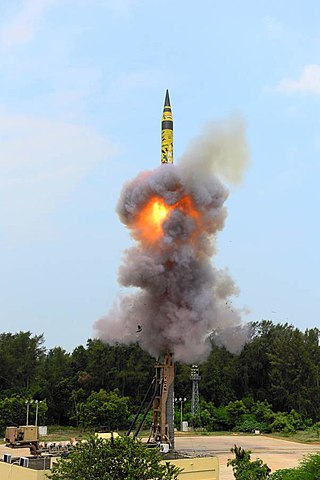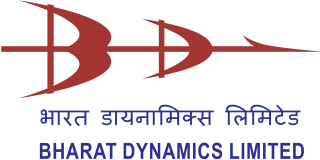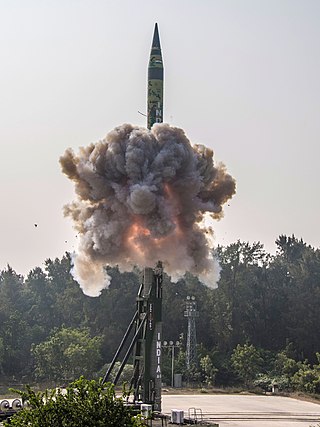Related Research Articles

An intercontinental ballistic missile (ICBM) is a ballistic missile with a range greater than 5,500 kilometres (3,400 mi), primarily designed for nuclear weapons delivery. Conventional, chemical, and biological weapons can also be delivered with varying effectiveness, but have never been deployed on ICBMs. Most modern designs support multiple independently targetable reentry vehicle (MIRVs), allowing a single missile to carry several warheads, each of which can strike a different target. The United States, Russia, China, France, India, the United Kingdom, Israel, and North Korea are the only countries known to have operational ICBMs. Pakistan is the only nuclear-armed state that does not possess ICBMs.

The Agni-III is an Indian intermediate-range ballistic missile inducted into service in 2011 as the successor of the Agni-II. It has a range of 3,500 to 5,000 kilometres and can reach targets deep inside neighbouring countries including Pakistan & China.

India possesses nuclear weapons and previously developed chemical weapons. Although India has not released any official statements about the size of its nuclear arsenal, recent estimates suggest that India has 172 nuclear weapons and has produced enough weapons-grade plutonium for up to 200 nuclear weapons. In 1999, India was estimated to have 800 kilograms (1,800 lb) of separated reactor-grade plutonium, with a total amount of 8,300 kilograms (18,300 lb) of civilian plutonium, enough for approximately 1,000 nuclear weapons. India has conducted nuclear weapons tests in a pair of series namely Pokhran I and Pokhran II.

The Strategic Forces Command (SFC), sometimes called Strategic Nuclear Command, forms part of India's Nuclear Command Authority (NCA). It is responsible for the management and administration of the country's tactical and strategic nuclear weapons stockpile. It was created on 4 January 2003 by the Vajpayee Government. Air Marshal Teja Mohan Asthana became its first commander-in-chief.

Prithvi is a tactical surface-to-surface short-range ballistic missile (SRBM) developed by Defence Research and Development Organisation (DRDO) of India under the Integrated Guided Missile Development Program (IGMDP). It is deployed by India's Strategic Forces Command.

The Integrated Guided Missile Development Programme (IGMDP) was an Indian Ministry of Defence programme for the research and development of the comprehensive range of missiles. The programme was managed by the Defence Research and Development Organisation (DRDO) and Ordnance Factories Board in partnership with other Indian government political organisations. The project started in 1982–83 under the leadership of Abdul Kalam who oversaw its ending in 2008 after these strategic missiles were successfully developed.

The National Command Authority (NCA) is the authority responsible for safeguarding the national security of Pakistan through command, control and operational decisions regarding Pakistan's nuclear weapons programme.

Agni-II, is the second strategic ballistic missile of the Agni family envisaged to be the mainstay of the Indian missile-based strategic nuclear deterrence. The Agni-II is a medium-range ballistic missile (MRBM) with two solid fuel stages and a Post Boost Vehicle (PBV) integrated into the missile's Re-entry Vehicle (RV). The Agni's manoeuvring RV is made of a carbon-carbon composite material that is light and able to sustain high thermal stresses of re-entry, in a variety of trajectories. The Agni-IIA is a more advanced version of Agni-II, albeit with more sophisticated and lighter materials, yielding a better range and operating regime. Agni-IIA was later renamed as Agni-IV plugging the gap between Agni-II and Agni-III. While the first test of Agni-IV in December 2010 was a failure, the second test flight in November 2011 was a success Agni-II, developed as part of medium- and long-range Agni series of missile systems, has already been inducted into the Armed Forces.

The Indian Armed Forces are the military forces of the Republic of India. It consists of three professional uniformed services: the Indian Army, Indian Navy, and Indian Air Force. Additionally, the Indian Armed Forces are supported by the Central Armed Police Forces, Indian Coast Guard and Special Frontier Force and various inter-service commands and institutions such as the Strategic Forces Command, the Andaman and Nicobar Command and the Integrated Defence Staff. The President of India is the Supreme Commander of the Indian Armed Forces but the executive authority and responsibility for national security is vested in the Prime Minister of India and their chosen Cabinet Ministers. The Indian Armed Forces are under the management of the Ministry of Defence of the Government of India. With strength of over 1.4 million active personnel, it is the world's second-largest military force and has the world's largest volunteer army. It also has the third-largest defence budget in the world. The Global Firepower Index report lists it as the fourth most-powerful military.

The Agni missile is a family of medium to intercontinental range ballistic missiles developed by India, named after one of the five elements of nature. Agni missiles are long-range, nuclear weapons capable, surface-to-surface ballistic missiles. The first missile of the series, Agni-I was developed under the Integrated Guided Missile Development Programme (lGMDP) and tested in 1989. After its success, the Agni missile programme was separated from the GMDP upon realizing its strategic importance. It was designated as a special programme in India's defence budget and provided adequate funds for subsequent development. As of November 2019, the missiles in the Agni series are being inducted into service. The family comprises the following:

Agni-IV ("Fire") is the fourth in the Agni series of missiles which was earlier known as Agni II prime. It has been developed by India's DRDO and displayed a number of new technologies and significant improvement in missile technology. The missile is light-weight and has two stages of solid propulsion and a payload with re-entry heat shield. With 4,000 km range, it is capable of striking targets in nearly all of mainland China, if launched from northeastern part of India.

Bharat Dynamics Limited (BDL) is one of India's manufacturers of ammunitions and missile systems. It was founded in 1970 in Hyderabad, India. BDL was established to be a manufacturing base for guided weapon systems and begun with a pool of engineers drawn from Indian Ordnance Factories, DRDO and aerospace industries, it began by producing a first generation anti-tank guided missile - the French SS11B1. While fulfilling its basic role as a weapons system manufacturer, BDL has built up in-house R&D capabilities primarily focusing on design and engineering activities. BDL has three manufacturing units, located at Kanchanbagh, Hyderabad; Bhanur, Medak district, and Visakhapatnam, Andhra Pradesh.

Agni-I is a short-range ballistic missile that was developed by DRDO of India in the Integrated Guided Missile Development Program. It is a single-stage missile that was developed after the Kargil War to fill the gap between the 250 km (160-mile) range of the Prithvi-II missile and the 2,500 km (1,600-mile) range of the Agni-II. It was first launched from a road mobile launcher at Integrated Test Range (ITR), Wheeler Island, on 25 January 2002. Less than 75 launchers are deployed.

Agni-V is a land based nuclear MIRV-capable Intercontinental Ballistic Missile (ICBM) developed by the Defence Research and Development Organisation (DRDO) of India. The missile has a range of more than 7,000 km. It is a three-stage, road-mobile, canisterised and solid-fuelled ballistic missile. It is one of the fastest missiles in the world, reaching speeds up to 29,400 km/hr.
Agni-VI is an MIRV-capable intercontinental ballistic missile under development by the Defence Research and Development Organisation (DRDO) for the Strategic Forces Command (SFC) of the Indian Armed Forces.
India has studied, produced and used various strategic and tactical missile systems since its independence. Decades long projects have realised development of all types of missile systems including ballistic, cruise, anti-ship, air-defence, air-to-air and anti-missile systems. India is one of seven countries in the world with intercontinental ballistic missiles (ICBMs) and one of four countries with anti-ballistic missile systems. Since 2016, India has been a member of Missile Technology Control Regime (MTCR).

INS Dhruv (A40) is a research vessel and missile range instrumentation ship built by India's Hindustan Shipyard Limited (HSL). The ship was earlier only known by its shipyard designated yard number as VC-11184.

Pralay is a canisterised surface-to-surface, short-range ballistic missile (SRBM) for battlefield use developed by the Defence Research and Development Organisation (DRDO) of India. The missile is an amalgamation of technologies developed for exoatmospheric interceptor missile Prithvi Defence Vehicle (PDV) from the Indian Ballistic Missile Defence Programme, and the Prahaar tactical missile. The project to develop Pralay was sanctioned in March 2015 with a budget of ₹332.88 crore.

The Defence Space Agency (DSA) is an integrated tri-services agency of the Indian Armed Forces headquartered in Bengaluru, Karnataka, India. The agency is tasked with operating the space-warfare and Satellite Intelligence assets of India. The DSA draws personnel from all three branches of the Armed Forces.

Agni-Prime or Agni-P is a two-stage, surface to surface, canister-launched, road mobile and solid-fueled medium-range ballistic missile being developed by India's Defence Research and Development Organisation (DRDO) as the sixth missile in the Agni series. It is intended to be deployed in the operational service of the Strategic Forces Command, and to feature significant upgrades to the composite motor casing, a maneuverable reentry vehicle (MaRV) along with improved propellants, navigation and guidance systems.
References
- 1 2 "Indian Army wants sole right over post of Strategic Forces Commander". Zee News. 29 July 2013. Archived from the original on 4 September 2011. Retrieved 30 July 2013.
- ↑ "PIB Press Releases". archive.pib.gov.in. Retrieved 2 September 2021.
- ↑ Norris, Robert S. and Hans M. Kristensen. "India's nuclear forces, 2005 Archived 2008-11-19 at the Wayback Machine ," Bulletin of the Atomic Scientists 61:5 (September/October 2005): 73–75.
- ↑ India's Nuclear Weapons Program - Present Capabilities Archived 10 June 2012 at the Wayback Machine
- ↑ The Independent—Monday, June 21, 2004--"India and Pakistan to Have Nuclear Hotline": Archived 4 September 2011 at the Wayback Machine